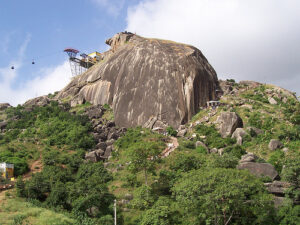
Gabbar (or Gabbargadh), is a small hillock about four km to the west of Ambaji village in Banaskantha district. The hill is considered to be the abode of Goddess Ambaji. It is one of the 51 ancient Shakti Peetha Tirth in India. It is believed that the heart of Devi Sati fell at the top of this hill, as described in the scripture “Tantra Chudamani”.
This temple of Ambaji Mata is very ancient, origin of which is lost in antiquity. It is believed that Goddess Amba was one of the deities of Pre- Aryan Race, which Aryans absorbed in their pantheon. On the Gabbar Hill the footsteps of Goddess are imprinted. The imprints of her chariot are also found here.
Climbing the Gabbar Hill is an important pilgrimage and attracts lakhs of pilgrim. The hill is very steep and difficult to climb. There are stone steps at the foot of the hill after which the pilgrims have to climb through a narrow dangerous track. On the flat top of the hill there is a small niche facing the temple of Ambaji, in which a well-protected lamp is kept constantly burning, and can be seen from the main Ambaji temple at night.
Millions of devotees visit the temple every year especially on Purnima days culminating into a large Mela on Bhadarvi Purnima.
Shri Arasuri Ambaji Mata Devsthan Trust has developed a parikrama way circulating the Gabbar hill. The 51 shaktipeeth temples are constructed on this Parikrama marg. The temples are made as same as they are at their original locations. One can darshan all 51 shaktipeeth by doing Parikrama of Gabbar hill.
Gabbar Hill in Ramayan
As per a legend said in Ramayan, Lord Rama and Laxman came to Ashram of Shrungi Rushi in search of Sitaji, where they were told to worship Devi Ambaji at Gabbar. Rama did so and Jagat Mata Shakti Devi Ambaji gave him a miraculous arrow namely “Ajay”, with the help of which Rama conquered and killed his enemy Ravan in the war.
Mundan of Lord Krishna
It is believed that the tonsure ceremony of Lord Krishna also took place here in presence of his foster parents Nand and Yashoda, who had worshiped Devi Ambaji and Lord Shiva, during the period of Dwapar yug.
This hill top is also famous for its rocks which are old and red in colour. One of the prime attractions of this hill top are cracks which remain filled with fresh water in rainy season and people from nearby villages come to fetch water from these springs.
Source:
http://www.gujarattourism.com/destination/details/10/47
http://www.99mustsee.com/India/Gabbar-hills-Banaskantha-Gujarat-Attractions-3459


